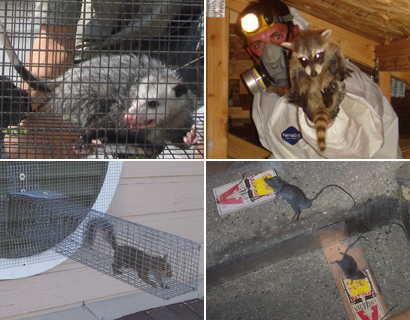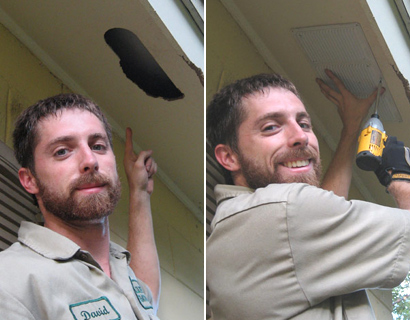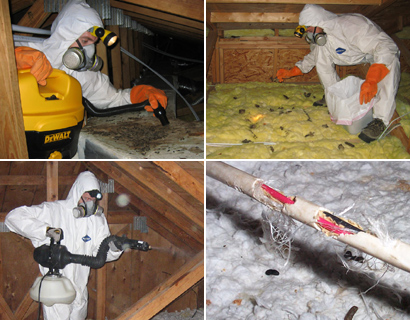- How We Solve Texas Wildlife Problems
How We Solve Dallas Wildlife Problems
INSPECTION: Once on site, we will perform a full inspection of your home and property. This allows us to use the correct strategy and traps. If the animals are in an attic, a full building inspection is crucial, including the following:
- All ground-level areas, such as piper or A/C line entry & exit areas, A/C chase bottoms, ground-level vents, etc.
- All mid-level areas, such as dryer vents, siding gaps, first floor eaves or dormers, etc.
- We inspect the entire roof, including all plumbing stacks, ridge caps, vents, and other potential gaps or holes.
- We also inspect inside your attic, to identify animals and damage they have caused.
- If the animals are outside, we notice many subtle clues that will assist us in a successful strategy.
TRAPPING, EXCLUSION, REMOVAL: Once we understand what animal species we are dealing with, and the problem, we use the most effective means of removing the animals. We use dozens of different types of traps.
- Trapping - If trapping the animal(s) in live cage traps, trap type, set, and location are crucial to success.
- Exclusion - Oftentimes, we are able to simply set one-way doors or other exclusion devices that allow the animals inside a building to safely exit, but never get back inside.
- Removal By Hand - Sometimes we actually remove animals by hand, or with special tools like snare poles.
- The Law - In all cases, we obey state and local laws regarding wildlife, but aim to take the most humane approach.
ENTRY HOLE REPAIRS: Repairs are a crucial step in the wildlife removal process. In many cases, such as bat or rodent control, the job cannot be performed without detailed repairs, and in all cases, sealing the entry holes shut ensures that no future wildlife will ever enter your home.
- 100% of the entry holes must be found, and sealed shut, or the job is not complete.
- Our repairs are professional contractor grade, look good, and when applicable we use steel, which rodents such as rats or squirrels are unable to chew through.
- We give a written guarantee on our repairs against any future animal entry.
ATTIC DECONTAMINATION SERVICES: It may be desirable to clean your attic after we've removed the animals. They can leave behind large amounts of droppings, urine, hair, oils, food, nesting material, and so on. These remnants can attract insects like cockroaches, and the scent left behind can encourage new animals to chew their way into your house. You might experience odor problems from the waste. It's possible that mold will grow on waste areas.
- We remove or vacuum all droppings, or remove all the soiled insulation.
- We fog the attic with a special enzyme-based cleaner that destroys any organic matter and deodorizes the space.
- We repair damage, such as ductwork, electrical wires, pipes, insulation, and more.
How often do you inspect your home for entry points for wildlife critters? Birds, squirrels, and mice can easily find their way into your attic by creating little holes. If you do find some wildlife critters in your attic, dont worry! We specialize in trapping and removing them from your home. We answer our phones 24 hours a day, 7 days a week! We service Dallas, as well as the following cities: Addison, Balch Springs, Cedar Hill, Cockrell Hill, Combine, Coppell, Duncanville, Farmers Branch, Ferris, Glenn Heights, Grapevine, Hutchins, Lancaster, Ovilla, Rowlett, Sachse, Seagoville, University Park, Wilmer, Wylie, Frisco, McKinney, Plano, Carrollton, Richardson, Garland, Rockwall, Mesquite, DeSoto, Grand Prairie, and Irving. We also service the following counties: Anderson, Andrews, Angelina, Aransas, Duval, Eastland, Ector, Edwards, El Paso, Ellis, Erath, Falls, Fannin, Fayette, Fishe, King, Kinney, Kleberg, Knox, La Salle, Lamar, Lamb, Lampasas, Lavaca, Lee, Leon, Liberty, and Limestone.
Other Dallas animal pest control topics:
Do Squirrels Chew on Wood in or on a House?
Mating Habits of Common Rats
About Raccoons
Are Bats Blind
To learn more about our services, visit the Dallas wildlife control home page.
This month's wildlife how-to article: The Pigmy Rattlesnake
The Pigmy Rattlesnake
Appearance
Pigmy rattlesnakes appear short and have thick bodies for snakes. As their name suggests, they are in fact, smaller than most rattlesnakes. In fact, an adult pigmy rattlesnake will only be over a half a meter long with both females and males roughly the same size.
Biology
The pigmy rattlesnake that is also known as “sistrurus millarius”, is a toxic snake that is often found in the southeastern parts of the United States.
They are also called by other names such as:
• Ground rattler
• Spottled rattler
• Bastard rattlesnake
• Southern rattlesnake
• Spotted rattlesnake
• Small rattlesnake
There are three subspecies of pigmy rattlesnake:
• Carolina pigmy (S.m. miliarius)
• Dusky pigmy (S.m. barbouri)
• Western pigmy (S.m. streckeri)
Life Cycle
The average life span of pigmy rattlesnakes can reach up to twenty years! They reach their sexual maturity within three years of age. Female pigmy rattlesnakes, like other pitvipers, are ovoviviparous which means that they give birth to live young. The eggs hatch within the female's body first and then they come out like miniture versions of their parents though they have slightly lighter coloration to their parents. Females can give birth to five to eight young.
Habitat
These snakes live in the southeastern parts of the United States such as:
• Texas
• South Carolina
• Alabama
• Florida
• Missouri
• Louisiana
However, they are reported to be found mostly in Florida in areas such as:
• Woodland areas
• Around marshes and other bodies of water (rivers, lakes)
Diet
Like most other snakes, pigmy rattlesnakes are carnivorous.
They will eat meat that comes from:
• Mice
• Rats
• Squirrels
• Birds
• Lizards
• Frogs
• Toads
• Insects
• Other snakes
They will use their venom to subdue their prey before eating their prey whole. Pigmy rattlesnakes are hunters that like to sneak up on their prey to catch them unawares.
Behavior
Like other pitvipers, pigmy rattlesnakes are night-time creatures (nocturnal). As with most rattlesnakes, they will shake their tails vigorously when they feel threatened or to issue a warning to would be predators. Pigmy rattlesnakes have been found to be highly dangerous because of their small size - you don't see them until you are on top of them! And are highly aggressive towards humans in particular. However, it is good to know that the venom from a pigmy rattlesnake is not enough to kill a full grown human but it is still imperative that should you be bitten by one that you immediately be given medical attention.





